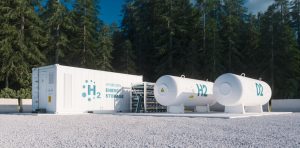Hydrogen Gas Is the Newest Renewable Energy Source

Renewable energy sources are rapidly replacing fossil fuels like coal and natural gas. But wind and solar can’t be used as baseload sources.
Both need some form of energy storage. Today, that is being handled by batteries.
Large lithium-ion batteries are seeing rapid deployment. Utilities and homeowners are installing them to solve their storage problems.
But now there’s another unique way to solve renewable energy’s storage problem: hydrogen gas.
Producing and Storing Hydrogen
At first, it might seem like renewable energy and hydrogen aren’t connected – but they are. Let me first show you how hydrogen is produced.
Hydrogen is one of the most abundant elements on Earth. However, it’s nearly always combined with other elements or compounds.
Hydrogen is also nonpolluting. When burned, it combines with oxygen. The result is heat and water. No carbon dioxide, nitrous oxide or sulfur dioxide.
In the U.S., the three largest hydrogen-producing states are Louisiana, Texas and California. Most of the hydrogen they produce is used to treat metals, process foods, make fertilizer and refine petroleum.
Hydrogen is fairly expensive to produce. Both the government and the industry have numerous research and development projects underway.
Both are aiming to develop technologies that drastically reduce the cost of producing hydrogen. The goal is to make hydrogen’s cost competitive with the costs of today’s fossil fuel-based transportation fuels.
There are many ways to produce hydrogen in commercial quantities.
For example, hydrogen can be produced by gasification. When you react natural gas with high-temperature steam, synthesis gas is created. This is a mixture of carbon dioxide, carbon monoxide and hydrogen.
The carbon monoxide is then reacted with water. This produces more hydrogen.
This is the most efficient, most common and cheapest way to make hydrogen. And it’s the way most of the hydrogen in the U.S. is made.
Hydrogen can also be produced in commercial quantities using fermentation.To do this, tanks full of biomass are converted into feedstocks rich in sugar. These are fermented to produce hydrogen.
Electrolysis can also be used to produce hydrogen. In this method, electricity is used to split water into hydrogen and oxygen. When electricity from renewable sources is used, the hydrogen produced is considered renewable too.
Electrolysis projects are called “power-to-hydrogen.” They’re really beginning to take off because they have many benefits.
The hydrogen produced can be stored in tanks. And it can be used later to power a steam turbine connected to a generator. The generator can run whenever peak power is needed.
This neatly solves the storage problem for solar and wind. No batteries needed.
Proof of Concept
In the U.K., a novel experiment is underway with hydrogen. The heating of the country’s homes and businesses is responsible for half of its energy consumption and one-third of its carbon dioxide emissions.
But now, in a groundbreaking experiment, hydrogen and natural gas are being blended together. The resulting mixture produces less greenhouse gases.
Right now, this is a small project. Just 100 homes and 30 Keele University buildings are being served.
But scientists estimate that if this technology were rolled out across the U.K., roughly 6 million tons of carbon dioxide emissions would be avoided annually. That’s the equivalent of permanently parking 2.5 million cars.
An electrolyzer is used to produce hydrogen for this project. And the electricity comes from excess renewable energy.
Customers don’t have to change appliance settings. And the mixture is just as safe as pure natural gas.
This trial is expected to continue through July 2020. Upon a successful completion, a larger project involving 670 customers will be rolled out.
This is just one exciting example of how hydrogen is rapidly emerging as a solution to renewable energy’s Achilles heel.
In future articles, I’ll explore other developments regarding this pollution-free gas.
Good investing,
Dave






